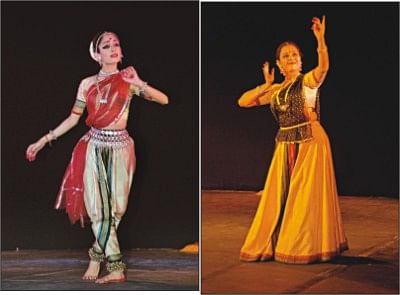Tagore for all seasons

The cyclical passage of time gracefully depicted by Arushi Mudgal and Monisha Nayak.
It's that time of the year when you bid adieu to a long, cold winter and ready to welcome the joyous and colourful season of Basanta or spring. The magic of changing seasons (“Ritu Rang”) is evocatively captured in Rabindra Sangeet. And what if it is combined with the graceful and lyrical Kathak and Odissi dances? You have a delightful mélange, titled “Tagore for the Six Seasons: Interpretations of Rabindra Sangeet in Odissi and Kathak.” The recital was held on February 9 at the India International Centre, a cultural hub of Delhi.
Madhavi Mudgal, the renowned Odissi dancer who hails from a family of illustrious musicians, had choreographed the show, while the dancers were her niece Arushi Mudgal (Odissi) and Monisha Nayak (Kathak). Explaining the nuances of the superb performance, Madhavi says, “In our concert we start with Basanta, go on to Grishma (summer), Barsha (rainy season), Sharat (early autumn), Hemanta (late autumn), Sheeth (winter) and once again return to Basanta. Tagore said that when the flower blossoms on the tree you think this is it, but within the flower is the fruit, within the fruit is the seed. Within the seed is the tree. So one element gives way to another. We take it as a finality but it is a cycle and that is what we tried to capture in this performance.”
This cyclical passage of time was gracefully depicted by Arushi and Monisha. The duo embarked on the concert with a duet on Basanta that set the tone for the evening. Then followed several solos and duets with intricate footwork and some amazing elements of abhinaya (expressions). The show ended with Basanta once more, complete with dandiya and the strewing of marigolds.
Odissi, believes Madhavi is “very conducive to bringing out the poetic aspect of Tagore because it is curved, it is rounded, it's lyrical. The lyricism of the poetry can be well depicted.”
While the two dancers performed with ease, much homework had to be done beforehand. Says Arushi, “It is interesting to perform Odissi with Tagore songs, but it is also very challenging because we do not do such concerts often, the poetry is so rich in itself and to do justice to it is difficult. First we have to understand the poem.”
Kathak dancer (Jaipur Gharana), Monisha Nayak, though a Bengali also found the fusing of her dance genre with Rabindra Sangeet a challenging experience. “Tagore's songs are more based on the taal, the rhythmic aspect, and have a very beautiful, aesthetic interpretation. Joining these elements with dance was difficult but very interesting,” she says.
While Arushi and Monisha stole the thunder, credit must, of course go to the talented seven accompanists behind the Rabindra Sangeet performance and Jayati Ghosh (vocals) in particular.
Madhavi and the two dancers are not novices to such performances. In March 2008, as part of “Utsav: Celebrating Tagore in the 21st century” Madhavi choreographed dance compositions of Tagore's "Ritu Rang" (or songs of the seasons). The four-day festival was jointly organised by the India International Centre and Shadhona.
And such “fusion” of two art forms is not entirely new, says Lubna Mariam, founder and general secretary of Shadhona.
“Tagore's entire concept of dance, and music, was one of sangmisran which is the word he coined much, much before the world adopted the word 'fusion' for music. So, this was definitely not the first time that fusion was being used for Rabindra Nritya. But, yes, this was a rare instance of a leading classical dancer experimenting with Tagore's songs,” she told this correspondent.

 For all latest news, follow The Daily Star's Google News channel.
For all latest news, follow The Daily Star's Google News channel. 



Comments